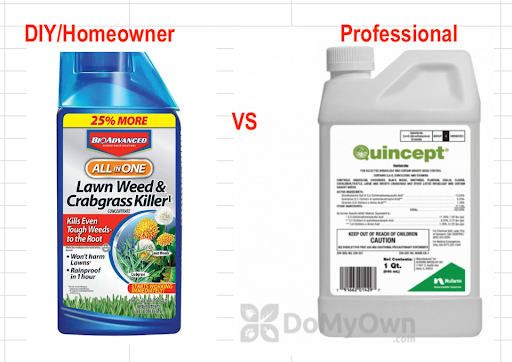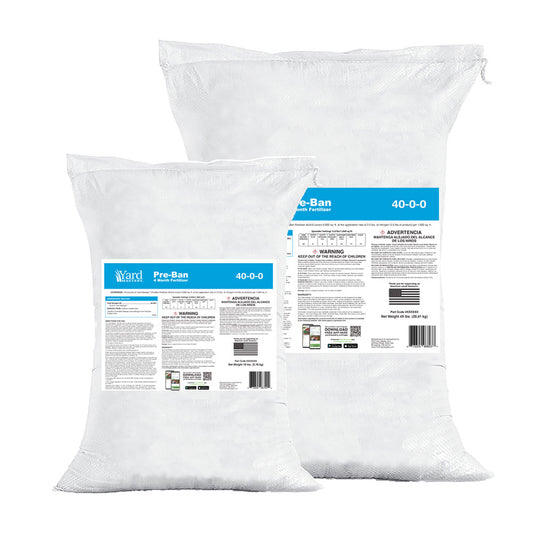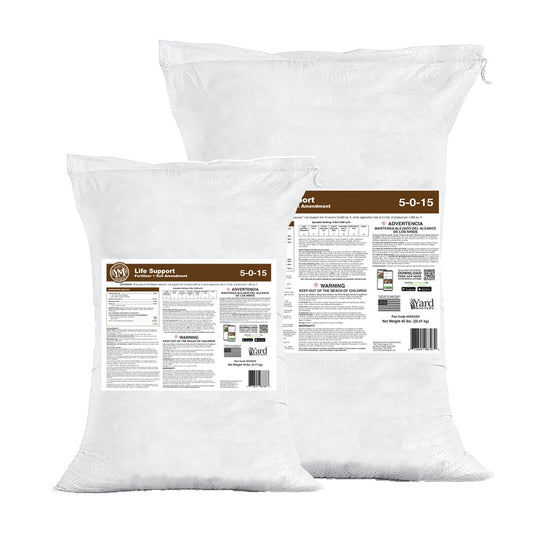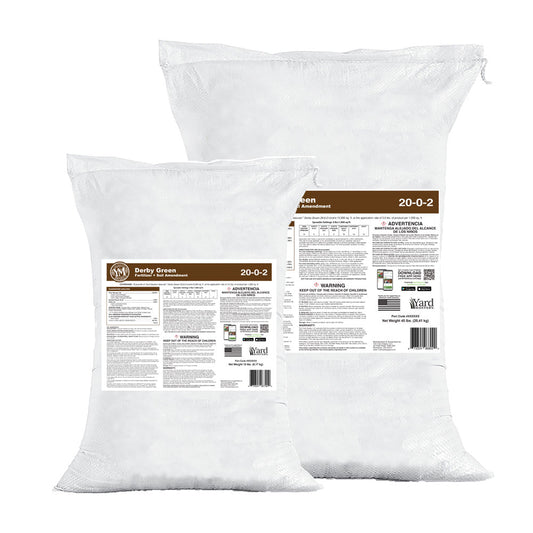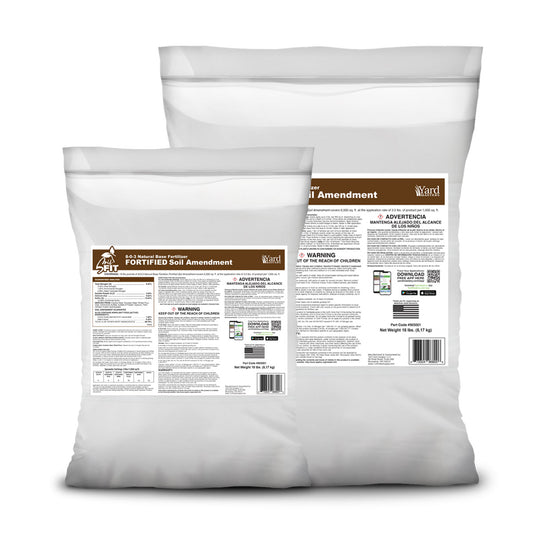Today we are going to have some fun learning about weed control, it’s cost and whether or not professional weed control is better than DIY/homeowner weed control from the big box retailers.
In this article I am focusing on cool season lawns (Kentucky Bluegrass, fescue, rye). If you want to read a similar article on weed control used in warm season turf, click here.
I also want to let you know these are post-emergent, selective herbicides. That means these herbicides are designed to kill existing weeds and they selectively target broadleaf weeds without harming the lawn.

I’ve personally used both of the weed controls we are going to look at today. Our DIY/homeowner weed control is BioAdvanced Weed and Crabgrass Killer and you can use it pretty much anytime in spring or summer on cool season lawns.
The professional formulation we are going to look at is Quincept herbicide by NuFarm which can be used in spring, but it’s really much better towards early summer when crabgrass escapees may be a challenge. When I worked for TruGreen in Chicago, we ran Quincept all summer as our primary weed and crabgrass control.
Active Ingredients
Both weed controls have the same active ingredients in them. 2,4-D, Dicamba and quinclorac.
BioAdvanced Weed and Crabgrass Killer
2,4-D, ......................................................... 4.85%
Quinclorac ................................................. 1.61%
Dicamba, ................................................ 0.45%
Quincept Herbicide by NuFarm
2,4-D...........................................13.24%
Quinclorac ....................................8.25%
Dicamba .......................................1.38%
2,4-D, Dicamba and Quinclorac are Synthetic Auxin Herbicides
Synthetic Auxins (Group 4) can also be referred to as plant growth regulators but not in the way most of you think about it. In our community, we often think of “plant growth regulators” as chems that slow down the lawn’s growth. Guys with bermudagrass especially will use them so they don’t have to reel mow every single day. “PGRs” are used alot on low cut lawns, but that’s a completely different class of chems.
The auxin growth regulators we are referring to with 2,4-D, Dicamba and Quinclorac do the opposite. They speed things up beyond the plants’ ability to survive.
Auxins are systemic herbicides which means they get inside the plant either through the leaves or the roots or both, and work their way up, down and all around the interior of the plant. They get in and speed up and disrupt the plant’s internal processes.
Broadleaf weeds exposed to auxin herbicides basically grow so fast they blow up from the inside out. At higher concentrations, you’ll see weeds twisting, curling and cupping, sometimes just a few hours after the application is made.
Picture it this way: do you remember the scene from Raiders of the Lost Ark where Belloq and Toht’s heads melt and explode when the wrath of God gets into them? It literally looks like that when the broadleaf weed dies. The only difference is that the weed may take a week or more to completely blow itself out but along the way, it looks just like that clip from Raiders; just green and yellow instead of red.
Here is a list of weeds that these 3 herbicides will kill according to the label:

From my experience, these will do just fine on the common weeds you face like dandelions, clover, oxalis, spurge, chickweed, henbit and plantain.
They do not do very well on wild violet, creeping charlie (ground ivy) or thistle. If you have problems with these, get this.
Quinclorac Kills Crabgrass
I wanted to give you a little bit more information on quinclorac because of the weeds it kills. It’s mode of action is the same as 2,4-D and Dicamba, but the plants it affects are a little different. Crabgrass is the main one we think of when using quinclorac. It will turn it red and that’s how you know it’s pretty much dead.
But quinclorac is also very effective on white clover infestations which can be pretty bad in the later spring across the midwest and into the east. It’s also good on foxtail which is a big problem through alot of the midwest.
Concentrations DIY Homeowner vs Professional
Did you notice the percentages next to each of the active ingredients? Let’s look at them again for each product and then I’ll show you something that will surprise you.
BioAdvanced Weed and Crabgrass Killer
2,4-D, ......................................................... 4.85%
Quinclorac ................................................. 1.61%
Dicamba, ................................................ 0.45%

The concentrated BioAdvanced bottle is 32 oz. Of that 32 oz, 4.85% is 2,4-D, 1.61% is Quinclorac and .45% if Dicamba. That means that in that bottle, there is literally only:
32 x 4.85% = 1.6 oz of 2,4-D
32 x 1.61% = .52 oz of Quinclorac
32 x .45% = .14 oz of Dicamba
So in the entire bottle that is 32 oz, the active ingredients only make up 2.26 oz of actual “chemical weed killer”
I’m pointing this out because I want you to see how efficient these chems are at very low use rates. Just wait until we mix this in water and then it will really be clear to you.
Here is that same math on the Quincept Herbicide product. It is also available in a 32 oz quart. (hat tip to NuFarm for making this weed control available in a smaller size!)
Quincept Herbicide by NuFarm
2,4-D...........................................13.24%
Quinclorac ....................................8.25%
Dicamba .......................................1.38%

32 x 13.24% = 4.2 oz of 2,4-D
32 x 8.25% = 2.64 oz of Quinclorac
32 x 1.38% = .44 oz of Dicamba
So you can see that just looking at things side by side, there is quite a bit more active ingredient in the professionally formulated Quincept than there is in the DIY/Homeowner BioAdvanced.
How Much To Mix - Application Rates
There is one more piece of information we need and that is the recommended use rate. Each product will tell you on the label how much of the concentrate is to be sprayed across each 1,000 sq ft of lawn area.
If you missed it, I made a video where I talk about some of the standards we use in lawn care and the first is that everything is broken down into increments of 1,000 sq ft. In lawn care, we always talk in units of 1,000 sq ft when spraying or spreading.
The other standard is that when spraying liquids, 1 gallon of spray mix covers 1,000 sq ft.
Here are the mix rates for BioAdvanced Lawn Weed and Crabgrass Killer (from the label)

Now just as soon as I give you the standard of 1 gallon of spray mix covers 1,000 sq ft, the folks at BioAdvanced go and break that rule. You can see on their label they want each gallon to cover only 500 Sq Ft. They are literally the only company that breaks things down this way. They do this because a higher dilution leaves more room for error.
No worries though, I’m going to convert it for you and you will be just fine. If the rate of 3.2oz covers 500 sq ft, then that means that 6.4 oz can cover 1,000 sq ft. We are still mixing that 6.4 oz into 1 gallon of water.
So mark this down: BioAdvanced Lawn Weed Killer 6.4 oz/gallon and 1 gallon of spray mix covers 1,000 sq ft of lawn area.
(for those of you who are concerned about dilution rates, don’t be. It’s fine)
Now that we know we are using 6.4 oz per 1,000 sq ft, we can see how much actual active ingredient is going on the lawn.
Remember these numbers here:
BioAdvanced Weed and Crabgrass Killer
2,4-D, ......................................................... 4.85%
Quinclorac ................................................. 1.61%
Dicamba, ................................................ 0.45%
Let’s apply this application rate now to the concentrations of each product.
6.4 x 4.85% = .31 oz of 2,4-D
6.4 x 1.61% = .10 oz of Quinclorac
6.4 x .45% = .03 oz of Dicamba
So that is the actual amount of active ingredient that will be killing weeds across each 1,000 sq ft of lawn area. Just take a minute and notice that - these chems are SUPER efficient when it only takes less than an ounce of each to kill weeds across an entire 1,000 sq ft area.
Are you ready to be surprised?
Let’s do the same math using the application rate on the Quincept Herbicide, our professional formulation.
Quincept Herbicide by NuFarm
2,4-D...........................................13.24%
Quinclorac ....................................8.25%
Dicamba .......................................1.38%
The application rate here is 2.9 oz / 1,000 sq ft. Let’s apply this rate to the percentages we looked at earlier and see what that reveals.
2.9 x 13.24% = .38 oz of 2,4-D
2.9 x 8.25% = .24 oz of Quinclorac
2.9 x 1.38% = .04 oz of Dicamba
So what do you see here? What I see is that when it comes to the concentrations of 2,4-D and Dicamba, both of these products are very close to the same and that is because of the labeled application rates.
However, when you look at Quinclorac, you can see that the Quincept has a much higher concentration even with that lower use rate. It’s more than double.
So far then, we can see that the professional formulation doesn’t really stand out too much against the store bought option unless you are specifically targeting crabgrass which isn’t really anything to worry about until the middle or end of summer when crabgrass break-through would appear.
So then the only other comparison to be made would be price.
Cost Comparison of BioAdvanced vs Quincept
This will be pretty easy since both of these products come in a 32 oz qt. Here’s how they line up:
Bio-Advanced Lawn Weed and Crabgrass Killer

Size: 32 oz
Cost: $13.98
Application Rate: 6.4 oz / 1,000 / gallon
Coverage: 5,000 sq ft
32 / 6.4 = 5,000 sq ft
Cost per 1,000 sq ft: $2.64
$13.98 / 5 = $2.64
Quincept Herbicide by NuFarm

Size: 32 oz
Cost: $60.52
Application Rate: 2.9 oz / 1,000 / gallon
Coverage: 11,000 sq ft
32 / 2.9 = 11,000 sq ft
Cost per 1,000 sq ft: $5.50
$60.52 / 11 = $5.50
Conclusion Professional vs DIY/Homeowner Weed Control
So what have we learned?
These two weed controls have the same active ingredients at different concentrations. When you read the label and discover the application rate, you find that they actually are very similar on two of the active ingredients, 2,4-D and Dicamba.
The Quincept does have double the amount of quinclorac which is great for crabgrass, foxtail and clover - but it also costs quite a bit more. Quincept costs $5.50 per 1,000 sq ft whereas the Bio-Advanced is only $2.64 per 1,000 sq ft.
This is why my recommendation to DIYers is to always use a store bought weed control first. Then if you think you need something with a little more power, you can look at professional formulations. In this case, Quincept isn’t really a good option because I don’t thing the added cost is worth it for that higher concentration of Quinclorac.
I hope this article has been helpful and taught you how to do some math to really understand what you are paying for when you get out there to spray.
I’ll see you in the lawn!


